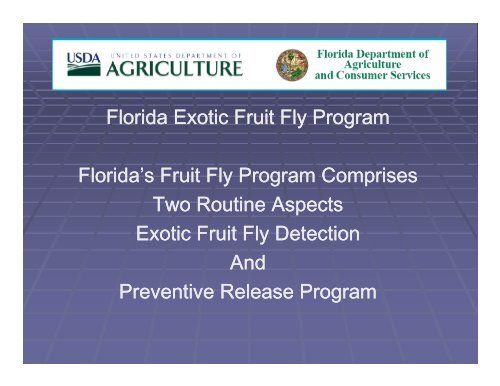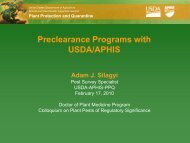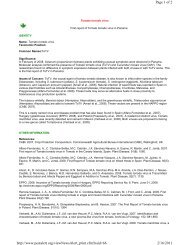Florida Exotic Fruit Fly Program
Florida Exotic Fruit Fly Program
Florida Exotic Fruit Fly Program
Create successful ePaper yourself
Turn your PDF publications into a flip-book with our unique Google optimized e-Paper software.
<strong>Florida</strong> <strong>Florida</strong> <strong>Exotic</strong> <strong>Fruit</strong> <strong>Fly</strong> <strong>Program</strong><br />
Fl <strong>Florida</strong>’s id ’ F <strong>Fruit</strong> it <strong>Fly</strong> Fl P <strong>Program</strong> C Comprises i<br />
Two Routine Aspects<br />
<strong>Exotic</strong> <strong>Fruit</strong> <strong>Fly</strong> Detection<br />
And<br />
Preventive Release <strong>Program</strong>
Sterile Insect Release Facility (SIRF)<br />
Preventative Release <strong>Program</strong> g ( (PRP) )<br />
Sarasota, <strong>Florida</strong><br />
SIRF/PRP<br />
�� �� prevents the establishment and spread of<br />
any intentional or accidental introduction of<br />
Mediterranean <strong>Fruit</strong> <strong>Fly</strong> y<br />
into <strong>Florida</strong>.
Cooperative Effort Between<br />
USDA and FDACS<br />
�� �� APHIS APHIS, PPQ handles purchase purchase, rearing rearing,<br />
and release of sterile flies<br />
�� FDACS FDACS-DPI DPI conducts d t survey and d<br />
identification of flies caught in traps<br />
�� APHIS APHIS-PPQ PPQ also conducts survey in these<br />
high risk areas
The Role of the SIRF/PRP<br />
�� Initially, it was to provide an emergency<br />
response to a Med fly outbreak<br />
�� Tampa outbreak of 1998<br />
�� �� Eliminate the the need need for aerial pesticides<br />
�� Proactive approach to the threat of Med fly<br />
introduction<br />
�� Prevent the establishment of Med fly by<br />
maintaining i t i i a sterile t il f fruit it fl fly population l ti<br />
�� Miami/Dade County<br />
�� Tampa/Hillsborough County<br />
�� Sarasota/Manatee Counties
Miami Dade Release Area<br />
Approximately Approximately 140 square miles
Hillsborough Release Area<br />
Approximately 300 square miles
Manatee/Sarasota Release Area<br />
Approximately 160 square miles
Advantages of SIRF/PRP<br />
�� Safe for the public-no public no pesticide<br />
�� �� No ad adverse erse impact on en environment ironment<br />
�� Biologically based<br />
�� Species specific<br />
�� Cost effective method<br />
�� Prevention<br />
�� Suppression<br />
�� Eradication
Pupae Distribution Room
Emergence Towers
Evaluation of Baits and Traps
Dispersal Dispersal Machine in Aircraft
FLORIDA’S<br />
EXOTIC FRUIT FLY<br />
DETECTION PROGRAM<br />
COORDINATORS<br />
Edward Cusano Wayne Clifton<br />
United States Department of Agriculture<br />
<strong>Florida</strong> Department of Agriculture And Consumer Services
Introduction:<br />
�� What are “ “Economic Economic” ” fruit flies?<br />
• Those fruit flies that can directly or indirectly cause<br />
economic losses both locally and nationally<br />
• How many fruit flies are considered to be Economic Economic?<br />
• Of 4 4,352 352 species species, only about 1 1.7% 7% have the potential to<br />
become pests; yet, they are among the most costly pests<br />
�� What are some characteristics of Economic fruit flies?<br />
• Wide host range<br />
• Wide climatic range<br />
• High reproductive capacity<br />
�� What is the role of the Survey Specialist?<br />
• Early y detection of Economic fruit flies through g vigilant g<br />
monitoring
PRODUCTION PRODUCTION COST<br />
COST<br />
EXISTING FRUIT FLY POPULATIONS<br />
INCREASE FRUIT AND VEGETABLE COSTS<br />
FOR CONSUMERS AND PRODUCTION<br />
COSTS FOR FOR PRODUCERS.<br />
PRODUCERS<br />
CARIBBEAN FRUIT FRUIT FLY FLY PROTOCOL PROGRAM<br />
PROGRAM<br />
IS A GOOD EXAMPLE OF WHY WE SHOULD<br />
NOT ALLOW ESTABLISHMENT OF EXOTIC<br />
FRUIT FLIES.
Major j Genera of Economic <strong>Fruit</strong> Flies<br />
�� �� Anastrepha<br />
and their Origins<br />
nastrepha: : Neotropical Neotropical Region (West<br />
Indies, South and Central America)<br />
�� Bactrocera<br />
actrocera: : Oriental, Australasian and<br />
Oceanic Regions (Tropical Asia, Australia,<br />
New Zealand and Pacific Islands)<br />
�� Ceratitis<br />
eratitis: : Ethiopian Ethiopian Region (sub Sahara<br />
Africa )<br />
�� �� Dacus<br />
acus acus: : Ethi Ethiopian i R Region i and d I Indian di<br />
subcontinent
The Family Tephritidae:<br />
Diagnostic Characters<br />
�� Characters Common to Tephritidae<br />
• Wings have color color pattern<br />
• Subcostal vein is bent forward at 90 90° angle<br />
• Posterior Posterior cubital wing cell ( (CuP ( (CuP CuP) ) has a<br />
pointed extension<br />
�� �� Females have a chitinized ovipositor<br />
sheath
WHAT ARE YOUR<br />
TARGETS?<br />
�� ANASTREPHA<br />
�� BACTROCERA<br />
�� �� CERATITIS
Anastrepha: Mexican <strong>Fruit</strong> <strong>Fly</strong> on Citrus
�� Size<br />
The Genus:<br />
Genus:<br />
Anastrepha<br />
• 200 spp., 15 pests<br />
�� Distribution<br />
• Neotropical Region<br />
�� Potential Pests<br />
• A. ludens (Mexican Mexican <strong>Fruit</strong> <strong>Fly</strong> <strong>Fly</strong>)<br />
• A. fraterculus (South South American <strong>Fruit</strong> <strong>Fly</strong> <strong>Fly</strong>)<br />
• A. obliqua q (West ( West Indian <strong>Fruit</strong> <strong>Fly</strong> <strong>Fly</strong>) y)
Anastrepha ludens<br />
MMexican i F<strong>Fruit</strong> itFl <strong>Fly</strong>
Anastrepha<br />
fraterculus<br />
South<br />
American<br />
<strong>Fruit</strong> <strong>Fly</strong>
Anastrepha<br />
obliqua<br />
West Indies<br />
<strong>Fruit</strong> <strong>Fly</strong>
Anastrepha suspensa Larvae in Surinam Cherry
Bactrocera Bactrocera: Melon fly on watermelon
Genus: Bactrocera / Dacus<br />
�� Size<br />
• Bactrocera 440 spp, 40 pests<br />
• Dacus 240 spp spp, 11 pests<br />
�� Distribution<br />
• Ethiopian, Oriental, Australasian and Oceanic<br />
Regions<br />
�� Potential Pests<br />
• B. dorsalis (Oriental Oriental <strong>Fruit</strong> <strong>Fly</strong> <strong>Fly</strong>)<br />
• B. cucurbitae (Melon Melon <strong>Fruit</strong> <strong>Fly</strong> <strong>Fly</strong>)<br />
• B B. carambolae (Carambola Carambola <strong>Fruit</strong> <strong>Fly</strong> <strong>Fly</strong>) <strong>Fly</strong> <strong>Fly</strong>)<br />
• B. correcta (Guava Guava <strong>Fruit</strong> <strong>Fly</strong> <strong>Fly</strong>)
Bactrocera<br />
correcta<br />
Guava<br />
<strong>Fruit</strong> <strong>Fly</strong>
Bactrocera<br />
latifrons<br />
Solanum<br />
or<br />
Malaysian y<br />
<strong>Fruit</strong> <strong>Fly</strong>
Bactrocera cucurbitae<br />
Melon <strong>Fly</strong>
Ceratitis: Mediterranean <strong>Fruit</strong> <strong>Fly</strong> on Apple
�� Si Size<br />
Genus: Ceratitis<br />
• 78 species, 9 pests<br />
�� Distribution<br />
• Ethiopian Region<br />
�� Potential Pests<br />
• C. capitata (Mediterranean Mediterranean <strong>Fruit</strong> <strong>Fly</strong> <strong>Fly</strong>)<br />
• C. rosa (Natal Natal <strong>Fruit</strong> <strong>Fly</strong> <strong>Fly</strong>)
Ceratitis capitata Mediterranean <strong>Fruit</strong> <strong>Fly</strong>
Ceratitis rosa<br />
Natal <strong>Fruit</strong> <strong>Fly</strong>
Life Cycle: Mediterranean <strong>Fruit</strong> <strong>Fly</strong>
Adult Mediterranean <strong>Fruit</strong> <strong>Fly</strong> on Citrus Host
<strong>Fruit</strong> <strong>Fly</strong> Oviposition Damage on Grapefruit
<strong>Fruit</strong> <strong>Fly</strong> Eggs<br />
Eggs are deposited inside host fruit
<strong>Fruit</strong> <strong>Fly</strong> Larvae<br />
<strong>Fruit</strong> fly larvae develop inside host fruit
Third Instar Larva Damage in Grapefruit
<strong>Fruit</strong> <strong>Fly</strong> Pupae<br />
<strong>Fruit</strong> fly pupae are found in the soil beneath host
<strong>Fruit</strong> <strong>Fruit</strong> <strong>Fly</strong> <strong>Fly</strong> Attraction Attraction Arsenal<br />
Trimedlure Methyl Eugenol Cuelure<br />
Mediterranean Oriental FF<br />
FF<br />
Peach FF<br />
Natal FF Ceratitis<br />
punctata<br />
Melon FF<br />
Queensland FF<br />
Other Dacus &<br />
p Bactrocera<br />
Food baits (e.g. torula yeast) attract females of most<br />
species of fruit flies flies, including those such as the genus<br />
Anastrepha that do not respond to any known<br />
synthetic lure (parapheromone).<br />
(parapheromone)
Trap<br />
Types/<br />
Baits<br />
Target g<br />
Pest<br />
Common<br />
Jackson Trap Baited<br />
with Trimedlure plug<br />
Trap Types, Target Pest and Selected Host<br />
Jackson Trap Baited<br />
with Cuelure<br />
Jackson Trap Baited<br />
With Methyl Eugenol<br />
Medfly<br />
Melon <strong>Fly</strong><br />
Oriental <strong>Fruit</strong> <strong>Fly</strong>y<br />
Natal <strong>Fly</strong> & other<br />
Ceratitus spp. not<br />
pictured<br />
Host Sour Orange<br />
Calamondin<br />
Grapefruit<br />
Guava<br />
Mango<br />
Loquat<br />
Rose Apple<br />
Tropical almond<br />
Queensland <strong>Fruit</strong><br />
<strong>Fly</strong> not pictured<br />
Mango<br />
SSweet t OOrange g<br />
Cucumber<br />
Melons<br />
Peach<br />
Papaya<br />
Other Bactrocera spp<br />
not pictured<br />
Avocado<br />
Calamondin<br />
Carambola<br />
Fi Fig<br />
Guava<br />
Loquat<br />
Longan<br />
Lychee<br />
Sweet Orange<br />
Peach<br />
Sour Orange<br />
Tropical-almond<br />
Multi-Lure<br />
Trap<br />
Dual<br />
purposeTrap<br />
used in Medfly y<br />
Preventative<br />
release<br />
programs to<br />
detect wild flies.<br />
Also used for<br />
detection of<br />
Mexican <strong>Fruit</strong><br />
Flies & other<br />
Anastrepha spp.<br />
McPhail Trap<br />
Used<br />
forAnastrepha<br />
spp spp..<br />
Used in<br />
emergency<br />
programs and as<br />
a general<br />
detection trap.<br />
Mexican <strong>Fruit</strong> <strong>Fly</strong><br />
Avocado<br />
Grapefruit<br />
Mango<br />
Peach<br />
Sweet orange<br />
Rose Apple
Jackson Trap baited with:<br />
Trimedlure, Methyl Eugenol or Cuelure
Multi Multi-lure lure trap baited baited with:<br />
with:<br />
Three component synthetic lure
McPhail trap baited with torula yeast tablets
DETERMINE TARGET AREAS
ESTABLISH<br />
PROTOCOLS
CRITERIA DEFINITIONS<br />
Criteria I International Ports of Entry plus one mile<br />
surrounding the Port<br />
Criteria II Areas presenting high risk of illegal fruit introduction<br />
that may contain larvae. This would include all<br />
ddensely l populated l t d areas of f the th State, St t with ith<br />
coverage at local airports, private<br />
marinas, foreign labor camps and at fruit vendors<br />
known to handle International shipments.<br />
Criteria III Home sites on primary and secondary roads in rural<br />
areas where host are located. Consider businesses<br />
such as truck stops, markets, gas stations and other<br />
places people may congregate if host are available.<br />
Commercial fruit and vegetable production areas.<br />
Criteria IV Sections of land that are not accessible for trapping.<br />
This would include lakes, airport runways, and<br />
hheavily il forested f t d areas.
State S and<br />
Federal <strong>Fruit</strong> <strong>Fly</strong><br />
Trapping in<br />
<strong>Florida</strong>
Anastrepha Eradication <strong>Program</strong> Protocol<br />
Delimitation Delimitation Survey for for: for for: : Guava Guava <strong>Fruit</strong> <strong>Fly</strong> <strong>Fly</strong>, Mexican <strong>Fruit</strong> <strong>Fly</strong> <strong>Fly</strong>, South American <strong>Fruit</strong> <strong>Fly</strong> <strong>Fly</strong>,<br />
West Indian <strong>Fruit</strong> <strong>Fly</strong><br />
INSPECTION FREQUENCY: CORE traps are checked daily during the initial 77-day day period, period<br />
then serviced weekly. In the remainder of the array, traps are checked the day after initial<br />
placement, and then they are serviced every 7 days until eradication is declared. Only<br />
remove captures and replace the same liquid. Change the liquid and rebait every 7 days<br />
(weekly) (weekly).
Bactrocera or Dacus Species Responding to Cuelure<br />
Eradication <strong>Program</strong> Protocol<br />
Delimitation Survey for: Melon <strong>Fly</strong>, Queensland <strong>Fruit</strong> <strong>Fly</strong>, Lesser Queensland <strong>Fruit</strong> <strong>Fly</strong>,<br />
Pumpkin <strong>Fruit</strong> <strong>Fly</strong>.<br />
INSPECTION FREQUENCY : Core serviced every 3-4 days until first treatment, or as specified by the Scientific<br />
Advisory Committee. Following treatment, all traps in the array are run weekly.
Bactrocera or Dacus Species Responding to Methyl Eugenol<br />
Eradication <strong>Program</strong> Protocol<br />
Delimitation Survey for: Oriental <strong>Fruit</strong> <strong>Fly</strong>, Carambola <strong>Fruit</strong> <strong>Fly</strong>, Guava <strong>Fruit</strong> <strong>Fly</strong>,<br />
Peach <strong>Fruit</strong> <strong>Fly</strong>, Papaya <strong>Fruit</strong> <strong>Fly</strong>.
Medfly Eradication <strong>Program</strong> Protocol<br />
Delimitation Survey: When a Medfly is collected in an area that is<br />
not under the Preventative Release <strong>Program</strong>
MEDFLY ERADICATION PROGRAM<br />
Under the Preventive Release <strong>Program</strong> g<br />
Delimitation Survey: When a wild Medfly is detected in an area that is already<br />
under a sterile Medfly preventative release program, the total trap array<br />
sequence covers 9 square miles.<br />
il





